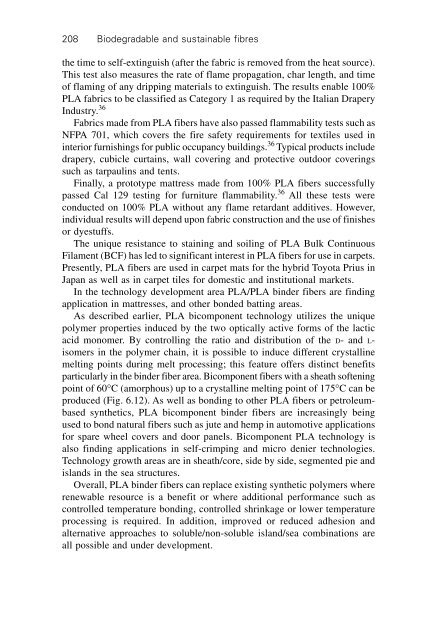Poly(lactic acid) fibers - Jim Lunt LLC
Poly(lactic acid) fibers - Jim Lunt LLC
Poly(lactic acid) fibers - Jim Lunt LLC
- No tags were found...
Create successful ePaper yourself
Turn your PDF publications into a flip-book with our unique Google optimized e-Paper software.
208Biodegradable and sustainable fibresthe time to self-extinguish (after the fabric is removed from the heat source).This test also measures the rate of flame propagation, char length, and timeof flaming of any dripping materials to extinguish. The results enable 100%PLA fabrics to be classified as Category 1 as required by the Italian DraperyIndustry. 36Fabrics made from PLA <strong>fibers</strong> have also passed flammability tests such asNFPA 701, which covers the fire safety requirements for textiles used ininterior furnishings for public occupancy buildings. 36 Typical products includedrapery, cubicle curtains, wall covering and protective outdoor coveringssuch as tarpaulins and tents.Finally, a prototype mattress made from 100% PLA <strong>fibers</strong> successfullypassed Cal 129 testing for furniture flammability. 36 All these tests wereconducted on 100% PLA without any flame retardant additives. However,individual results will depend upon fabric construction and the use of finishesor dyestuffs.The unique resistance to staining and soiling of PLA Bulk ContinuousFilament (BCF) has led to significant interest in PLA <strong>fibers</strong> for use in carpets.Presently, PLA <strong>fibers</strong> are used in carpet mats for the hybrid Toyota Prius inJapan as well as in carpet tiles for domestic and institutional markets.In the technology development area PLA/PLA binder <strong>fibers</strong> are findingapplication in mattresses, and other bonded batting areas.As described earlier, PLA bicomponent technology utilizes the uniquepolymer properties induced by the two optically active forms of the <strong>lactic</strong><strong>acid</strong> monomer. By controlling the ratio and distribution of the D- and L-isomers in the polymer chain, it is possible to induce different crystallinemelting points during melt processing; this feature offers distinct benefitsparticularly in the binder fiber area. Bicomponent <strong>fibers</strong> with a sheath softeningpoint of 60∞C (amorphous) up to a crystalline melting point of 175∞C can beproduced (Fig. 6.12). As well as bonding to other PLA <strong>fibers</strong> or petroleumbasedsynthetics, PLA bicomponent binder <strong>fibers</strong> are increasingly beingused to bond natural <strong>fibers</strong> such as jute and hemp in automotive applicationsfor spare wheel covers and door panels. Bicomponent PLA technology isalso finding applications in self-crimping and micro denier technologies.Technology growth areas are in sheath/core, side by side, segmented pie andislands in the sea structures.Overall, PLA binder <strong>fibers</strong> can replace existing synthetic polymers whererenewable resource is a benefit or where additional performance such ascontrolled temperature bonding, controlled shrinkage or lower temperatureprocessing is required. In addition, improved or reduced adhesion andalternative approaches to soluble/non-soluble island/sea combinations areall possible and under development.


